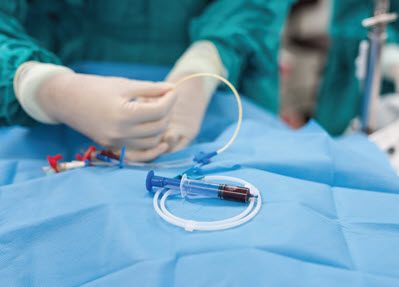Find out what other line is separately reportable with an SGC.
Most anesthesia coders know that line placements are typically included in the scope of service represented by ASA CPT® codes. Some may not realize, though, that there are times when the fee associated with the anesthesia code doesn’t include line placement. One of these exceptions is Swan-Ganz catheterization.
If you find yourself stumped by the ins and outs of Swan-Ganz coding, help is here. Let the answers to these FAQs guide you through the snags, so you’ll be well-equipped to submit airtight Swan-Ganz catheter (SGC) claims the next time one comes your way.

Q: What Is a Swan-Ganz Catheter?
A: The SGC is a long, thin tube with an inflatable balloon tip on the end that helps the catheter move smoothly through the blood vessels and heart. Providers first place an introducer sheath, or hollow tube, into a major vein — internal jugular, subclavian, femoral — which allows for the catheter to enter the body more easily. The SGC is then directed by blood flow through the veins, into the right side of the heart, and then into the pulmonary arteries (PAs) that carry blood to the lungs.
The SGC has multiple ports, each with a specific function:
Anesthesiologists typically place an SGC in patients with certain types of severe cardiac conditions, or whose cardiac function might be compromised prior to or during surgery.
Glossary: Don’t let different terminology in the documentation fool you. You might see the Swan-Ganz catheter referred to as a pulmonary artery catheter (PAC), according to Kelly D. Dennis, MBA, ACS-AN, CAN-PC, CHCA, CPMA, CPC, CPC-I, owner of Perfect Office Solutions in Leesburg, Florida. You might also see the SGC described as a balloon flotation flow-directed catheter.
Q: Why Is a Swan-Ganz Used?
A: The SGC is a diagnostic tool used to monitor heart and lung function, evaluate hemodynamics, and determine the effectiveness of medications. Clinicians use the SGC to measure several key indicators of cardiovascular function: central venous pressure (CVP), right atrial pressure, PA pressure, cardiac output (amount of blood ejected by the heart per minute), and venous oxyhemoglobin saturation (SvO2).
Be aware: Anesthesiologists “might use different catheters for other diagnostic or therapeutic purposes, and you need to distinguish those services,” says Terri Brame Joy, MBA, CPC, COC, CGSC, CPC-I, billing specialty subject matter expert at Kareo in Irvine, California.
For instance, they might place a central venous catheter (CVC) to measure CVP, for fluid delivery to adjust blood volume, or for drug infusion. Anesthesia providers might also place a central arterial line to monitor blood pressure.
You should be familiar with the following codes so that you’re prepared to report these cases:
Q: What’s Done in Cases With Multiple Catheters?
A: When you find op reports that mention these other types of catheters, you’ll need to unravel which are or aren’t separately reportable. Documentation of other lines placed in addition to the Swan-Ganz doesn’t automatically mean you can report each line separately. Pay attention to the details to verify what you can legitimately code.
Same access site: When placing an SGC, the anesthesiologist might thread it through a CVC line. According to anesthesia coding guidelines, the central line (36555 or 36556) is considered part of the Swan-Ganz procedure when placement is through the same access site. Because the CVC placement is included in the Swan-Ganz fee, you normally report only the SGC placement with 93503 instead of coding for both lines.
Different insertion sites: It’s not unusual for the anesthesiologist to place an SGC to monitor cardiac output and a separate CVC line at a different location based on the need for multiple intravenous access ports. If you have clear documentation supporting the separate sites, append modifier 59 (Distinct procedural service) or XS (Separate structure …) to the central line code to override the edit pair.
You’re in the clear, however, if the physician also places an arterial line in addition to the SGC. In cases where they document these two or all three lines, you can report both the arterial line (36620) and the SGC (93503) on the claim.

Q: Is Imaging Considered a Bundled Service?
A: It depends. After inserting an SGC, the anesthesiologist often performs a chest X-ray to confirm proper placement and positioning of the flow-directed catheter. When they do, you should not additionally report the chest X-ray because National Correct Coding Initiative (NCCI) edits bundle codes, such as 71045 (Radiologic examination, chest; single view), with 93503.
Here’s why: “Without new symptoms or other documented cause, you should always bundle standard diagnostic procedures as part of the primary procedure, such as electrocardiograms (EKGs) and X-rays that the provider performs pre and/or post-procedure to verify the work,” Brame-Joy says.
But when your doctor uses ultrasound guidance to aid with line placement, you can report add-on code +76937 (Ultrasound guidance for vascular access requiring ultrasound evaluation of potential access sites, documentation of selected vessel patency, concurrent realtime ultrasound visualization of vascular needle entry, with permanent recording and reporting …) along with line placement codes 36556, 93503, or 36620. Be sure to include modifier 26 (Professional component) for proper reimbursement.
Q: Which Diagnoses Support the SGC Service?
A: Your provider should document the specific reason for Swan-Ganz monitoring. Review the patient’s chart and medical history for potential diagnoses that would support medical necessity.
Although the advent of newer non-invasive technologies such as echocardiography may supplant Swan-Ganz in some cases, clinicians often still use SGC for circumstances including:
As such, you might see diagnoses that indicate medical necessity for SGC such as the following:
Resource: Check out this SGC guidance at www.asahq. org/standards-and-guidelines/statement-on-intravascular-catheterization-procedures.
